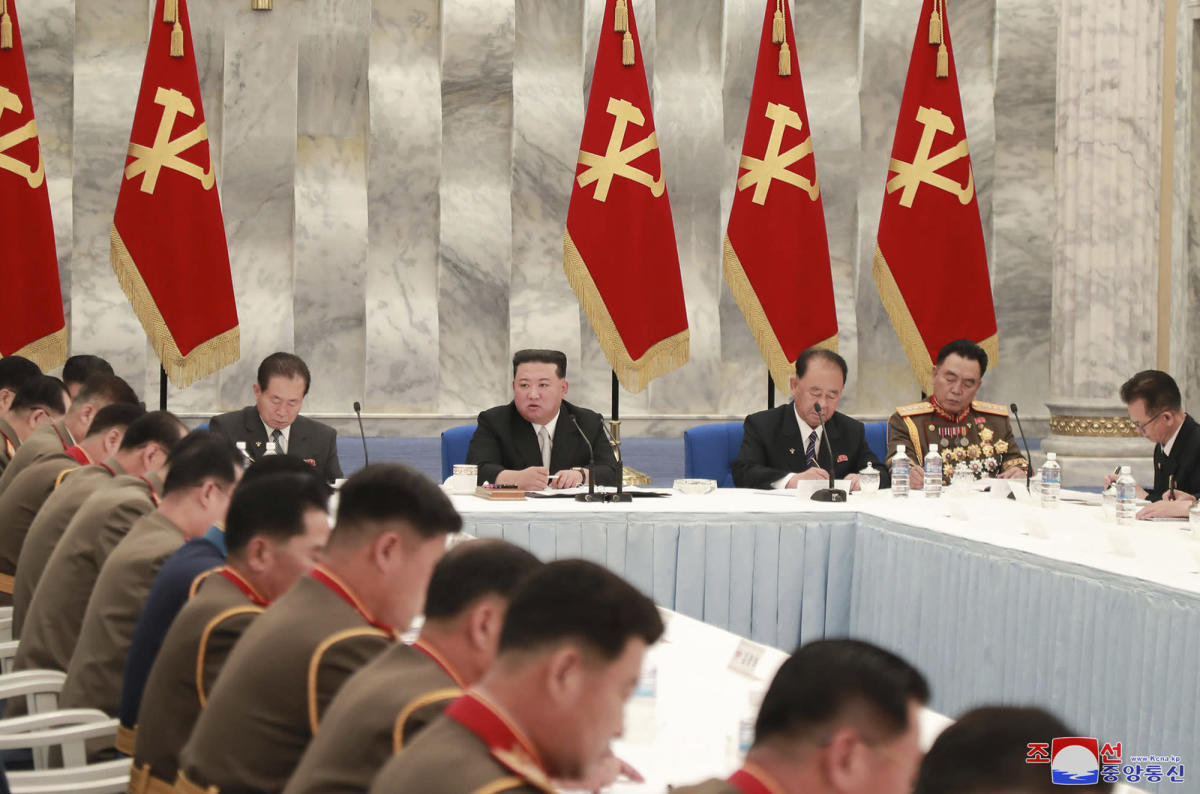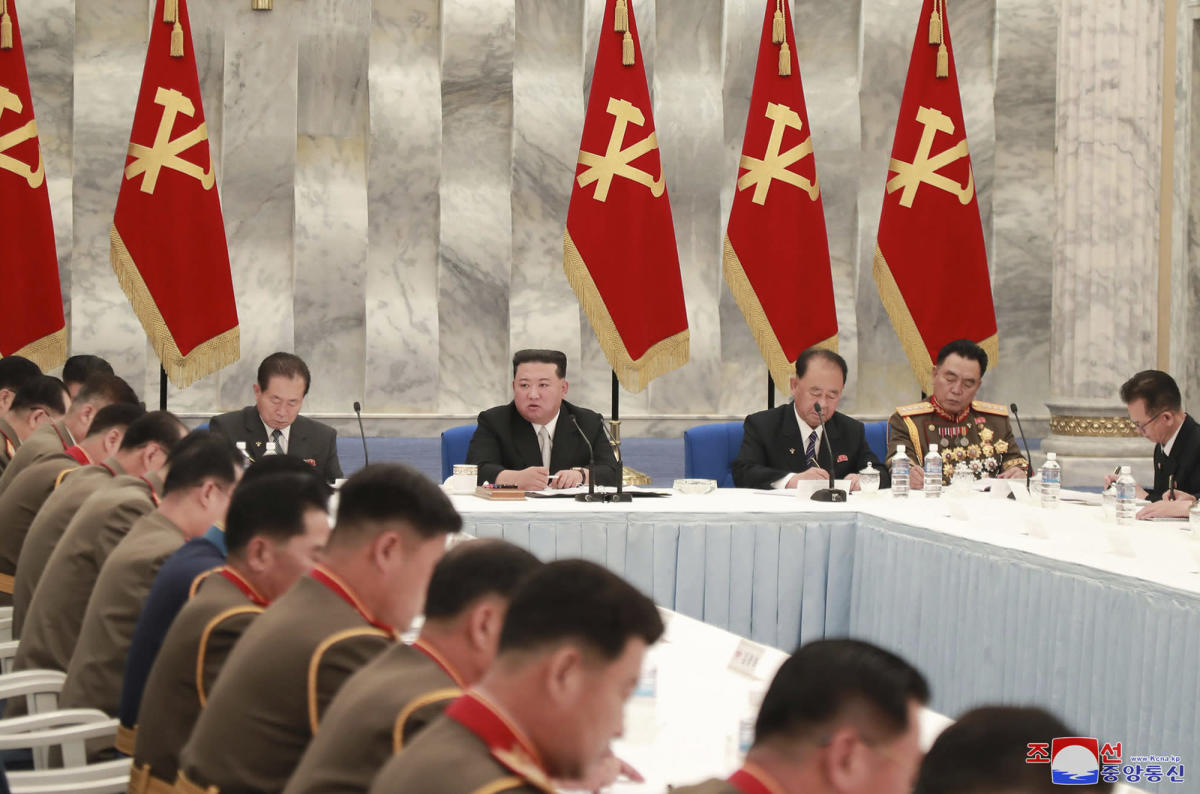
SEOUL, South Korea (AP) — Is North Korea preparing to deploy tactical nuclear weapons along its tense border with rival South Korea, which is only a short drive from the 26 million people living around Seoul, its capital?
That’s how it looks to many experts paying close attention to a high-profile North Korean military meeting this week. The possible deployment, just two months after a veiled threat by leader Kim Jong Un to preemptively use nuclear weapons, would be a major development in the decades-long standoff on the Korean Peninsula.
North Korea already has thousands of conventional weapons aimed at South Korea and the nearly 30,000 U.S. forces stationed there, but moving its short-range nuclear missiles to the border would be the clearest sign yet that Kim is looking to use his nuclear weapons to both threaten South Korea and wrest concessions from outside nuclear negotiators.
Together with North Korea’s apparent preparations for its first nuclear test in five years, there’s deep skepticism among observers that diplomacy can convince the country to abandon its nukes. Critics are calling on Seoul and Washington to formulate a new approach to deal with North Korea’s fast improving nuclear program.
Here’s a look at Kim’s latest nuclear moves.
___
NUCLEAR WEAPONS ON THE BORDER?
During a military meeting that ended Thursday, Kim and other senior officials confirmed additional “operation duties” and “modified operation plans” for military units near the border with South Korea.
State media dispatches didn’t mention nuclear weapons directly. But outside experts believe North Korea’s vague language signals its intention to forward-deploy tactical nuclear weapons systems. They base their assessment in part on recent public comments from North Korea about such plans, and on a slew of tests of short-range nuclear-capable missiles designed to attack strategic facilities in South Korea, including U.S. military bases there.
One big hint came in April, when North Korea test-fired a newly developed guided weapon that it said would improve the efficient operation of “tactical nukes” and boost the firepower of front-line artillery units. Later that month, Kim said he could use his nuclear program preemptively if provoked.
North Korea now has a “much higher chance to use its tactical nuclear weapons on a battlefield” if a war breaks out on the Korean Peninsula, said Kim Yeol Soo, an expert at South Korea’s Korea Institute for Military Affairs.
The weapons likely to be deployed at the border are some of the more mobile, solid-fueled, short-range missiles that North Korea has test-launched since nuclear diplomacy with the United States collapsed in 2019. North Korea has called those missiles — which foreign experts say are potentially capable of evading South Korean and U.S. missile defenses — “tactical” weapons, implying its intent to arm them with lower-yield nuclear weapons.
North Korea has likely already acquired the technology to arm its missiles with nuclear warheads, so its deployment of tactical nuclear weapons could happen any time, said Kim Taewoo, former head of the state-funded Korean Institute for National Unification in Seoul.
Some experts, however, said North Korea might not deploy nuclear-armed missiles because of possible problems maintaining them.
___
WILL SOUTH KOREA RESPOND BY DEPLOYING NUCLEAR WEAPONS?
North Korea’s apparent push to deploy tactical nuclear weapons may be part of Kim’s recent vow to counter the United States “strength for strength” amid stalled nuclear diplomacy. It also comes as Washington and Seoul work to strengthen their combined defense capabilities to cope with North Korean nuclear threats.
South Korea’s new conservative government, which took office last month, has said it will expand its conventional arms capabilities and strengthen its defenses in conjunction with the United States.
While the Koreas have avoided major conflict since the end of the 1950-53 Korean War, there have been deadly skirmishes and attacks in recent years that have killed dozens.
North Korea has a history of escalating threats and provocations when a new government is inaugurated in South Korea or the United States to create a potentially favorable environment for future negotiations. The country has often then dialed down its rhetoric and launched charm offensives.
That may happen this time.
But nuclear weapons on the front lines would complicate how South Korea responds to any future North Korean provocation.
New South Korean President Yoon Suk Yeol, during a summit with U.S. President Joe Biden last month, secured a U.S. commitment on the regional deployment of U.S. strategic assets such as long-range bombers and aircraft carriers in response to provocations by North Korea.
The allies may also conduct their largest combined military training in years in August.
But Yoon has said he won’t pursue nuclear development or ask the United States to redeploy nuclear weapons in South Korea as a deterrence against potential aggression by North Korea.
The South Korean military said it’s closely monitoring North Korean activities over the possible move to deploy tactical nuclear weapons, but didn’t elaborate.
Some experts say North Korea’s expansion of tactical nuclear weapons and pursuit of long-range missiles capable of reaching the U.S. mainland have reduced the credibility of America’s “nuclear umbrella,” though the Biden administration has repeatedly reaffirmed a U.S. commitment to defend South Korea with its full range of military capabilities.
There are also calls for the reintroduction of U.S. nuclear weapons in South Korea.
“We should switch to a strategy of terminating North Korea’s nuke threats through a nuclear balance,” said Kim Taewoo, the former head of the Korean Institute for National Unification. “The deployment of tactical nuclear weapons means that North Korea’s nuclear threat would be right in front of us.”
___
WHAT’S NEXT?
Tactical nuclear weapons were part of a five-year arms development plan Kim Jong Un announced last year. He has ramped up ballistic missile testing to an unprecedented pace this year to boost his country’s ability to attack both the U.S. mainland and South Korea.
For weeks, U.S. and South Korean officials have noted signs of an imminent nuclear test by North Korea, which would be its first since 2017 and seventh in total. Such a test could be part of an attempt to build a warhead that could fit on tactical missiles or multi-warhead missiles.
But North Korea hasn’t carried out such a test yet, possibly because of its continuing COVID-19 outbreak and opposition from China, its last major ally and biggest aid provider.
North Korea has so far rejected the Biden administration’s offers of open-ended talks, calling for Washington to first abandon its “hostile policy,” a term it uses in reference to U.S.-led economic sanctions and joint U.S.-South Korean military drills.
Experts say it’s only a matter of time before North Korea conducts a nuclear test, which is seen as an essential step in enlarging its nuclear arsenal under Kim’s five-year plan. Such a test would likely further complicate a push to resume nuclear diplomacy.




